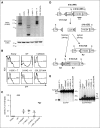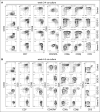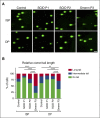Modeling altered T-cell development with induced pluripotent stem cells from patients with RAG1-dependent immune deficiencies
- PMID: 27301863
- PMCID: PMC4982452
- DOI: 10.1182/blood-2015-10-676304
Modeling altered T-cell development with induced pluripotent stem cells from patients with RAG1-dependent immune deficiencies
Abstract
Primary immunodeficiency diseases comprise a group of heterogeneous genetic defects that affect immune system development and/or function. Here we use in vitro differentiation of human induced pluripotent stem cells (iPSCs) generated from patients with different recombination-activating gene 1 (RAG1) mutations to assess T-cell development and T-cell receptor (TCR) V(D)J recombination. RAG1-mutants from severe combined immunodeficient (SCID) patient cells showed a failure to sustain progression beyond the CD3(--)CD4(-)CD8(-)CD7(+)CD5(+)CD38(-)CD31(-/lo)CD45RA(+) stage of T-cell development to reach the CD3(-/+)CD4(+)CD8(+)CD7(+)CD5(+)CD38(+)CD31(+)CD45RA(-) stage. Despite residual mutant RAG1 recombination activity from an Omenn syndrome (OS) patient, similar impaired T-cell differentiation was observed, due to increased single-strand DNA breaks that likely occur due to heterodimers consisting of both an N-terminal truncated and a catalytically dead RAG1. Furthermore, deep-sequencing analysis of TCR-β (TRB) and TCR-α (TRA) rearrangements of CD3(-)CD4(+)CD8(-) immature single-positive and CD3(+)CD4(+)CD8(+) double-positive cells showed severe restriction of repertoire diversity with preferential usage of few Variable, Diversity, and Joining genes, and skewed length distribution of the TRB and TRA complementary determining region 3 sequences from SCID and OS iPSC-derived cells, whereas control iPSCs yielded T-cell progenitors with a broadly diversified repertoire. Finally, no TRA/δ excision circles (TRECs), a marker of TRA/δ locus rearrangements, were detected in SCID and OS-derived T-lineage cells, consistent with a pre-TCR block in T-cell development. This study compares human T-cell development of SCID vs OS patients, and elucidates important differences that help to explain the wide range of immunologic phenotypes that result from different mutations within the same gene of various patients.
© 2016 by The American Society of Hematology.
Figures






Comment in
-
Modeling altered human T-cell development.Blood. 2016 Aug 11;128(6):743-5. doi: 10.1182/blood-2016-06-723908. Blood. 2016. PMID: 27516425 No abstract available.
Similar articles
-
Similar recombination-activating gene (RAG) mutations result in similar immunobiological effects but in different clinical phenotypes.J Allergy Clin Immunol. 2014 Apr;133(4):1124-33. doi: 10.1016/j.jaci.2013.11.028. Epub 2014 Jan 11. J Allergy Clin Immunol. 2014. PMID: 24418478 Free PMC article.
-
A systematic analysis of recombination activity and genotype-phenotype correlation in human recombination-activating gene 1 deficiency.J Allergy Clin Immunol. 2014 Apr;133(4):1099-108. doi: 10.1016/j.jaci.2013.10.007. Epub 2013 Nov 28. J Allergy Clin Immunol. 2014. PMID: 24290284 Free PMC article.
-
Human syndromes of immunodeficiency and dysregulation are characterized by distinct defects in T-cell receptor repertoire development.J Allergy Clin Immunol. 2014 Apr;133(4):1109-15. doi: 10.1016/j.jaci.2013.11.018. Epub 2014 Jan 7. J Allergy Clin Immunol. 2014. PMID: 24406074 Free PMC article.
-
[Omenn Syndrome and DNA recombination defects].Nihon Rinsho Meneki Gakkai Kaishi. 2017;40(3):179-189. doi: 10.2177/jsci.40.179. Nihon Rinsho Meneki Gakkai Kaishi. 2017. PMID: 28747605 Review. Japanese.
-
Human RAG mutations: biochemistry and clinical implications.Nat Rev Immunol. 2016 Apr;16(4):234-46. doi: 10.1038/nri.2016.28. Epub 2016 Mar 21. Nat Rev Immunol. 2016. PMID: 26996199 Free PMC article. Review.
Cited by
-
Cutting Edge: TCR-β Selection Is Required at the CD4+CD8+ Stage of Human T Cell Development.J Immunol. 2021 May 15;206(10):2271-2276. doi: 10.4049/jimmunol.2100141. Epub 2021 May 3. J Immunol. 2021. PMID: 33941655 Free PMC article.
-
Recent Updates on Induced Pluripotent Stem Cells in Hematological Disorders.Stem Cells Int. 2019 May 2;2019:5171032. doi: 10.1155/2019/5171032. eCollection 2019. Stem Cells Int. 2019. PMID: 31191673 Free PMC article. Review.
-
Novel NHEJ1 pathogenic variant linked to severe combined immunodeficiency, microcephaly, and abnormal T and B cell receptor repertoires.Front Pediatr. 2022 Jul 27;10:883173. doi: 10.3389/fped.2022.883173. eCollection 2022. Front Pediatr. 2022. PMID: 35967585 Free PMC article.
-
CRISPR-Cas9 engineering of the RAG2 locus via complete coding sequence replacement for therapeutic applications.Nat Commun. 2023 Oct 27;14(1):6771. doi: 10.1038/s41467-023-42036-5. Nat Commun. 2023. PMID: 37891182 Free PMC article.
-
Artificial thymic organoids represent a reliable tool to study T-cell differentiation in patients with severe T-cell lymphopenia.Blood Adv. 2020 Jun 23;4(12):2611-2616. doi: 10.1182/bloodadvances.2020001730. Blood Adv. 2020. PMID: 32556283 Free PMC article.
References
-
- Bassing CH, Swat W, Alt FW. The mechanism and regulation of chromosomal V(D)J recombination. Cell. 2002;109(suppl):S45–S55. - PubMed
-
- Roth DB, Menetski JP, Nakajima PB, Bosma MJ, Gellert M. V(D)J recombination: broken DNA molecules with covalently sealed (hairpin) coding ends in scid mouse thymocytes. Cell. 1992;70(6):983–991. - PubMed
-
- Fugmann SD. RAG1 and RAG2 in V(D)J recombination and transposition. Immunol Res. 2001;23(1):23–39. - PubMed
Publication types
MeSH terms
Substances
Grants and funding
LinkOut - more resources
Full Text Sources
Other Literature Sources
Research Materials

